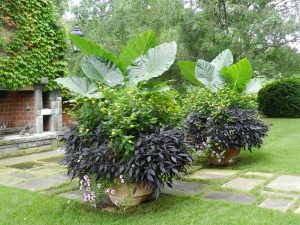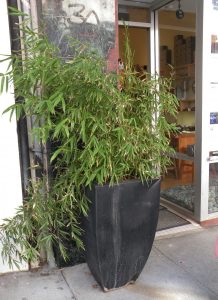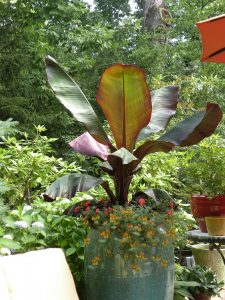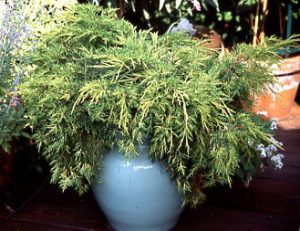How often do we see people stuffing their bodies into clothes that are too small? It’s not a pretty sight and the clothes are sure to split at the seams within a short period of time.
Although the effect is slightly different, something similar may happen if you put a large plant into a container that is too small. The wind will easily knock over the container or the roots may grow so quickly that they will push on the container walls and break them.
Actually, it’s a matter of scale. Large plants need large containers to be in balance with each other. In a way, this is a blessing because large containers don’t usually need to be watered as often as small ones.
Before we pick the appropriate container for a large plant, I want to make sure you know that you should not fill the bottom with anything other than soil. It is a myth that you should use gravel in the bottom to avoid the expense of using only soil. Water won’t run out into the gravel, or out of the pot until the soil is saturated. That soggy soil is likely to rot your plant’s roots. I’ve had great luck using leaf humus in my pots because it does not dry out as quickly as potting soil. You could mix the two but either way, you need good drainage and gravel in the bottom is not the answer.
The appropriate container will change depending on the way in which the plant is large. Is it tall? Wide? Both?

The Colocasia in this combination with Lantana, a black sweet potato vine, and petunias is too tall. If you cover it with your hand, you will see that the balance between plants and container is much better.

Containers of water loving plants: Colocasia esculenta, Cyperus ‘Baby Tut’ and ‘King Tut’, Juncus, Colocasia ‘Black Magic’ at the Niagara Botanical Garden
For instance, Colocasia gigantea ‘Thailand Giant’ is huge and grows both tall and wide. To be in balance, it needs a container that is nearly as tall and almost as wide (the leaves could arch out a bit from the sides of the container.
On the other hand, when not surrounded by voluminous underplantings, the balance will appear to be better even though the container may be a bit shorter.

Container combo of Croton, Ornamental Pepper, fall colored leaves, Pennisetum glaucum ‘Purple Majesty'(Millet), and flowering kale as seen in Chicago on the street.
Ornamental grasses tend to be tall and look great in tall and narrow containers but, again, scale is crucial. If you plant a grass, purchase it tall because it will take too long for it to grow to the necessary height.

Bamboo in San Francisco’s Chinatown;
We all know that bamboo can be a menace in the landscape but it’s a pussycat in a container as long as you know that you’ll have to divide it every year or every other year so it doesn’t break the pot. Bamboos can grow from three feet to twenty feet tall so pick your genus and species carefully.

Color echo of Ensete ventricosum ‘Maurellii’, table umbrella, Impatiens, and glazed pot on table; Cleveland residence
I love the maroon striping in the leaves of Ensete ‘Maurellii’ but it gets huge in the garden. However, by planting it in a container for only one season, you are constricting the ability of the roots to feed the leaves and promote growth.

Container sun combo: Conifer, Dusty Miller, Helichrysum lime, and petunia, at Detroit Garden Works

Juniperus pfitzeriana ‘Gold Lace’ in blue container on rooftop garden in Philadelphia
Conifers are excellent candidates for containers. They can be left in the container for several years, surrounded by perennials or annuals that can be changed each year. A conifer in a three or five gallon pot should not be too heavy to manage. Choose the size of the container to be in scale with the conifer at planting time since most conifers grow slowly. Of course, at some point you may want to transplant it into a larger container or into the landscape.
Have fun with large plants and remember to complement them with the right-sized container and other plants that either accent or contrast the foliage texture and form.


0 Comments